Analyzing the Impact of WTO on Cambodia's Poverty Reduction
VerifiedAdded on 2022/10/11
|20
|5138
|11
Essay
AI Summary
This essay examines the World Trade Organization's (WTO) impact on Cambodia's economic development, specifically focusing on poverty reduction. It begins by providing background on the WTO and its role in global trade, followed by an overview of Cambodia's economic situation and the factors contributing to its poverty. The essay then analyzes the WTO's influence on Cambodia's trade policies, macro-economic management, and investment climate, highlighting the country's adherence to WTO guidelines and the resulting economic gains. It explores the contributions of the WTO in encouraging economic diversification, integrating the informal sector, and facilitating trade agreements. The essay also discusses the current economic situation in Cambodia, including its transition to lower-middle-income status and the government's aspirations for further economic advancement. Finally, it provides findings, analysis, recommendations, and a conclusion summarizing the role of WTO in Cambodia's economic growth and the alleviation of poverty.
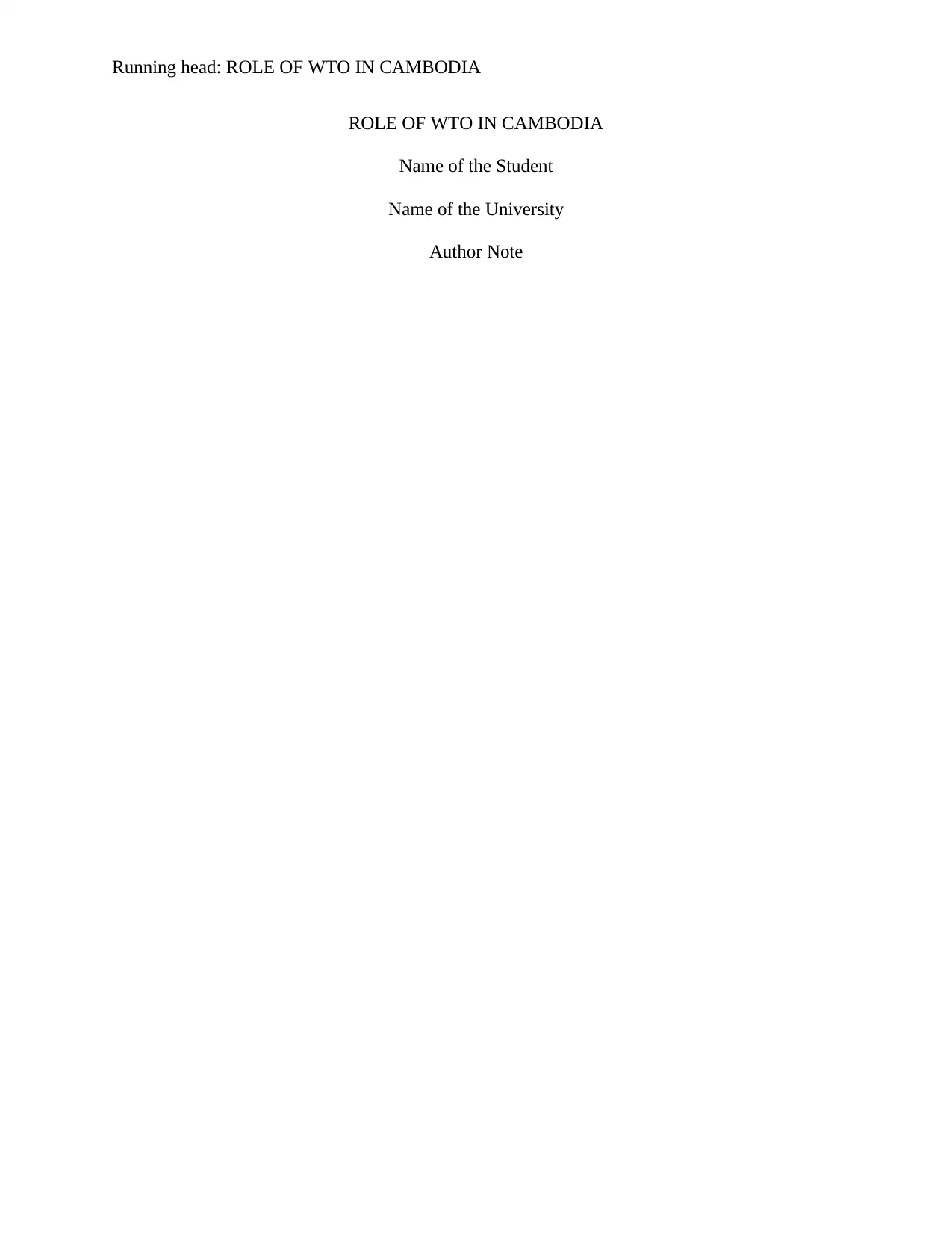
Running head: ROLE OF WTO IN CAMBODIA
ROLE OF WTO IN CAMBODIA
Name of the Student
Name of the University
Author Note
ROLE OF WTO IN CAMBODIA
Name of the Student
Name of the University
Author Note
Paraphrase This Document
Need a fresh take? Get an instant paraphrase of this document with our AI Paraphraser
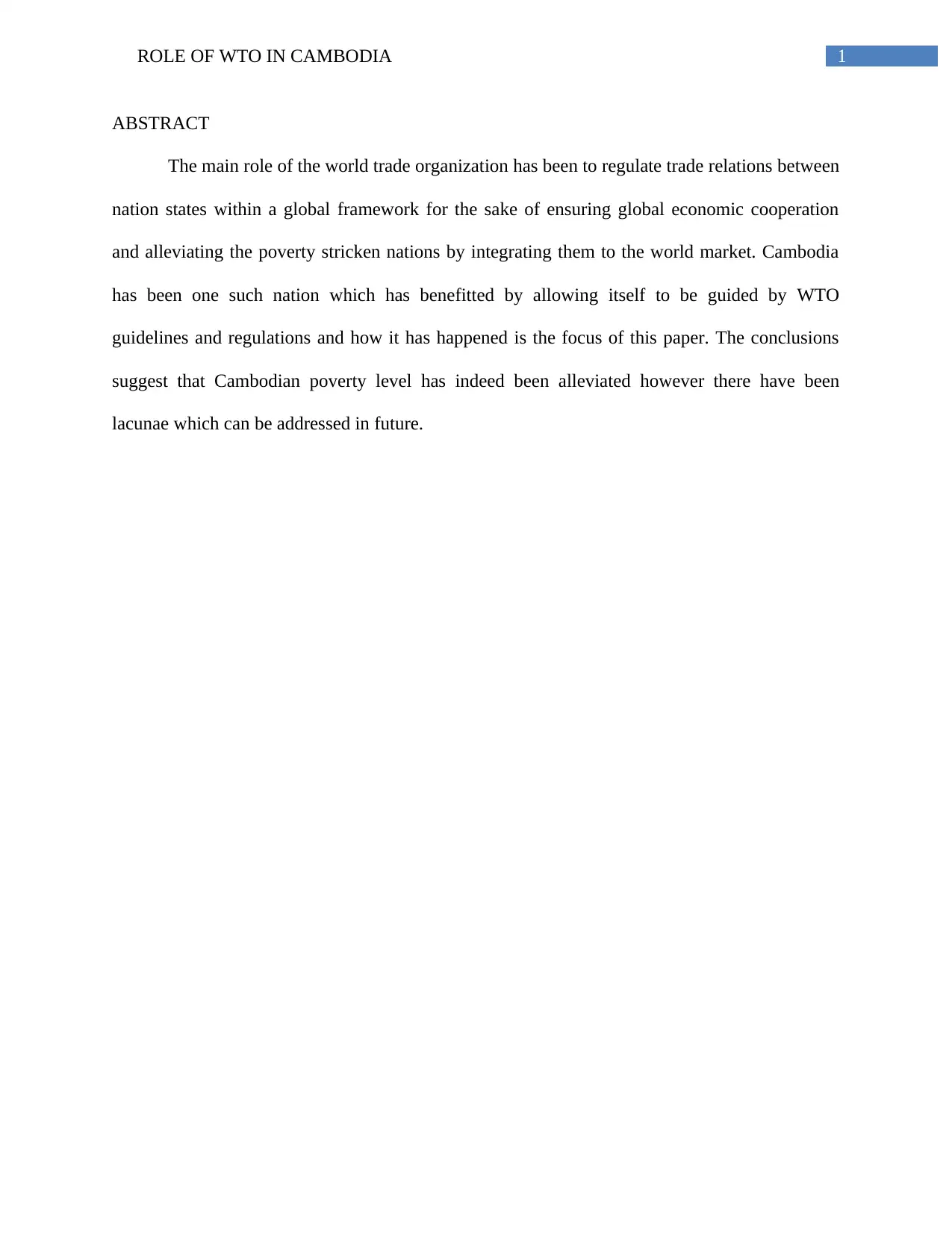
1ROLE OF WTO IN CAMBODIA
ABSTRACT
The main role of the world trade organization has been to regulate trade relations between
nation states within a global framework for the sake of ensuring global economic cooperation
and alleviating the poverty stricken nations by integrating them to the world market. Cambodia
has been one such nation which has benefitted by allowing itself to be guided by WTO
guidelines and regulations and how it has happened is the focus of this paper. The conclusions
suggest that Cambodian poverty level has indeed been alleviated however there have been
lacunae which can be addressed in future.
ABSTRACT
The main role of the world trade organization has been to regulate trade relations between
nation states within a global framework for the sake of ensuring global economic cooperation
and alleviating the poverty stricken nations by integrating them to the world market. Cambodia
has been one such nation which has benefitted by allowing itself to be guided by WTO
guidelines and regulations and how it has happened is the focus of this paper. The conclusions
suggest that Cambodian poverty level has indeed been alleviated however there have been
lacunae which can be addressed in future.
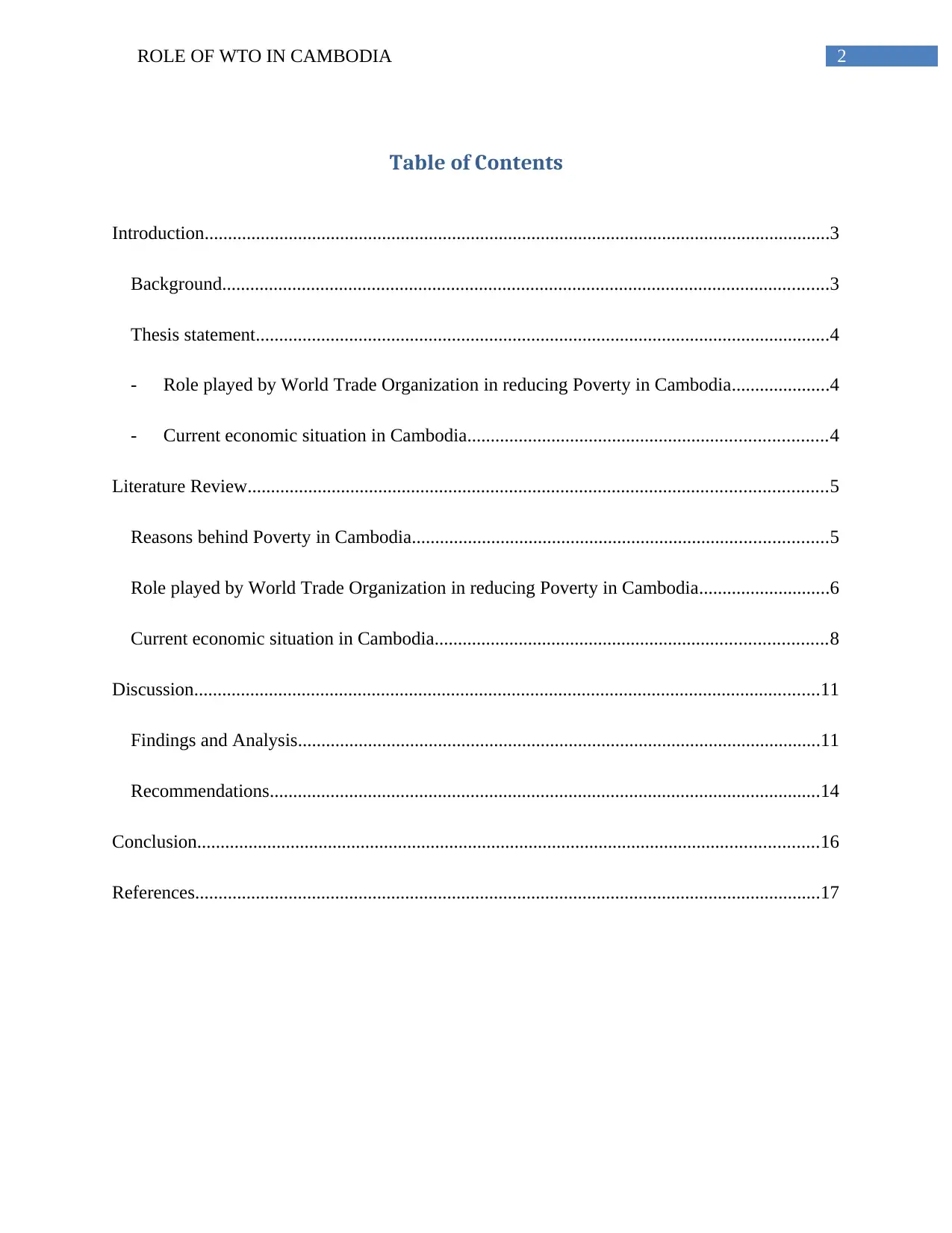
2ROLE OF WTO IN CAMBODIA
Table of Contents
Introduction......................................................................................................................................3
Background..................................................................................................................................3
Thesis statement...........................................................................................................................4
- Role played by World Trade Organization in reducing Poverty in Cambodia.....................4
- Current economic situation in Cambodia.............................................................................4
Literature Review............................................................................................................................5
Reasons behind Poverty in Cambodia.........................................................................................5
Role played by World Trade Organization in reducing Poverty in Cambodia............................6
Current economic situation in Cambodia....................................................................................8
Discussion......................................................................................................................................11
Findings and Analysis................................................................................................................11
Recommendations......................................................................................................................14
Conclusion.....................................................................................................................................16
References......................................................................................................................................17
Table of Contents
Introduction......................................................................................................................................3
Background..................................................................................................................................3
Thesis statement...........................................................................................................................4
- Role played by World Trade Organization in reducing Poverty in Cambodia.....................4
- Current economic situation in Cambodia.............................................................................4
Literature Review............................................................................................................................5
Reasons behind Poverty in Cambodia.........................................................................................5
Role played by World Trade Organization in reducing Poverty in Cambodia............................6
Current economic situation in Cambodia....................................................................................8
Discussion......................................................................................................................................11
Findings and Analysis................................................................................................................11
Recommendations......................................................................................................................14
Conclusion.....................................................................................................................................16
References......................................................................................................................................17
⊘ This is a preview!⊘
Do you want full access?
Subscribe today to unlock all pages.

Trusted by 1+ million students worldwide
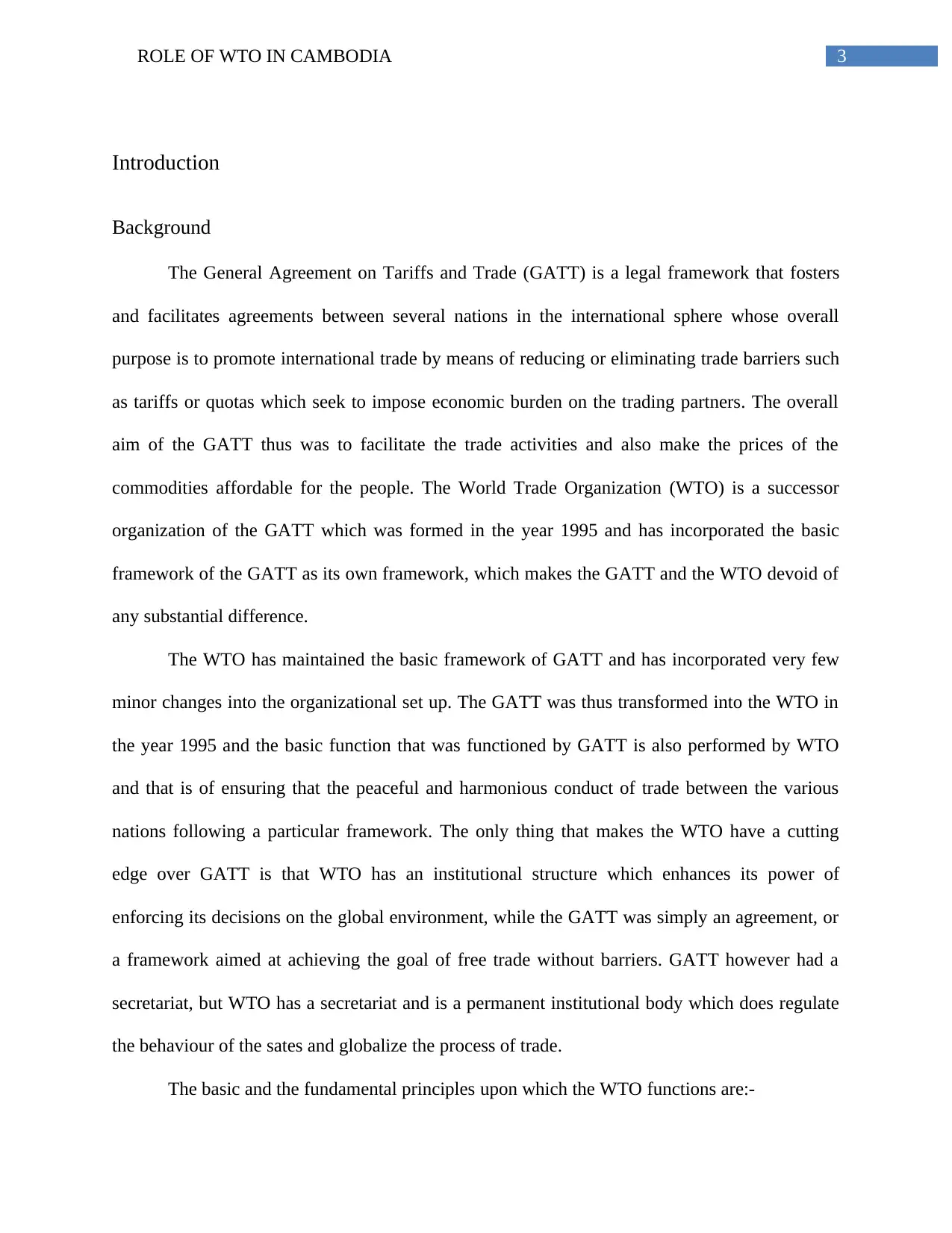
3ROLE OF WTO IN CAMBODIA
Introduction
Background
The General Agreement on Tariffs and Trade (GATT) is a legal framework that fosters
and facilitates agreements between several nations in the international sphere whose overall
purpose is to promote international trade by means of reducing or eliminating trade barriers such
as tariffs or quotas which seek to impose economic burden on the trading partners. The overall
aim of the GATT thus was to facilitate the trade activities and also make the prices of the
commodities affordable for the people. The World Trade Organization (WTO) is a successor
organization of the GATT which was formed in the year 1995 and has incorporated the basic
framework of the GATT as its own framework, which makes the GATT and the WTO devoid of
any substantial difference.
The WTO has maintained the basic framework of GATT and has incorporated very few
minor changes into the organizational set up. The GATT was thus transformed into the WTO in
the year 1995 and the basic function that was functioned by GATT is also performed by WTO
and that is of ensuring that the peaceful and harmonious conduct of trade between the various
nations following a particular framework. The only thing that makes the WTO have a cutting
edge over GATT is that WTO has an institutional structure which enhances its power of
enforcing its decisions on the global environment, while the GATT was simply an agreement, or
a framework aimed at achieving the goal of free trade without barriers. GATT however had a
secretariat, but WTO has a secretariat and is a permanent institutional body which does regulate
the behaviour of the sates and globalize the process of trade.
The basic and the fundamental principles upon which the WTO functions are:-
Introduction
Background
The General Agreement on Tariffs and Trade (GATT) is a legal framework that fosters
and facilitates agreements between several nations in the international sphere whose overall
purpose is to promote international trade by means of reducing or eliminating trade barriers such
as tariffs or quotas which seek to impose economic burden on the trading partners. The overall
aim of the GATT thus was to facilitate the trade activities and also make the prices of the
commodities affordable for the people. The World Trade Organization (WTO) is a successor
organization of the GATT which was formed in the year 1995 and has incorporated the basic
framework of the GATT as its own framework, which makes the GATT and the WTO devoid of
any substantial difference.
The WTO has maintained the basic framework of GATT and has incorporated very few
minor changes into the organizational set up. The GATT was thus transformed into the WTO in
the year 1995 and the basic function that was functioned by GATT is also performed by WTO
and that is of ensuring that the peaceful and harmonious conduct of trade between the various
nations following a particular framework. The only thing that makes the WTO have a cutting
edge over GATT is that WTO has an institutional structure which enhances its power of
enforcing its decisions on the global environment, while the GATT was simply an agreement, or
a framework aimed at achieving the goal of free trade without barriers. GATT however had a
secretariat, but WTO has a secretariat and is a permanent institutional body which does regulate
the behaviour of the sates and globalize the process of trade.
The basic and the fundamental principles upon which the WTO functions are:-
Paraphrase This Document
Need a fresh take? Get an instant paraphrase of this document with our AI Paraphraser
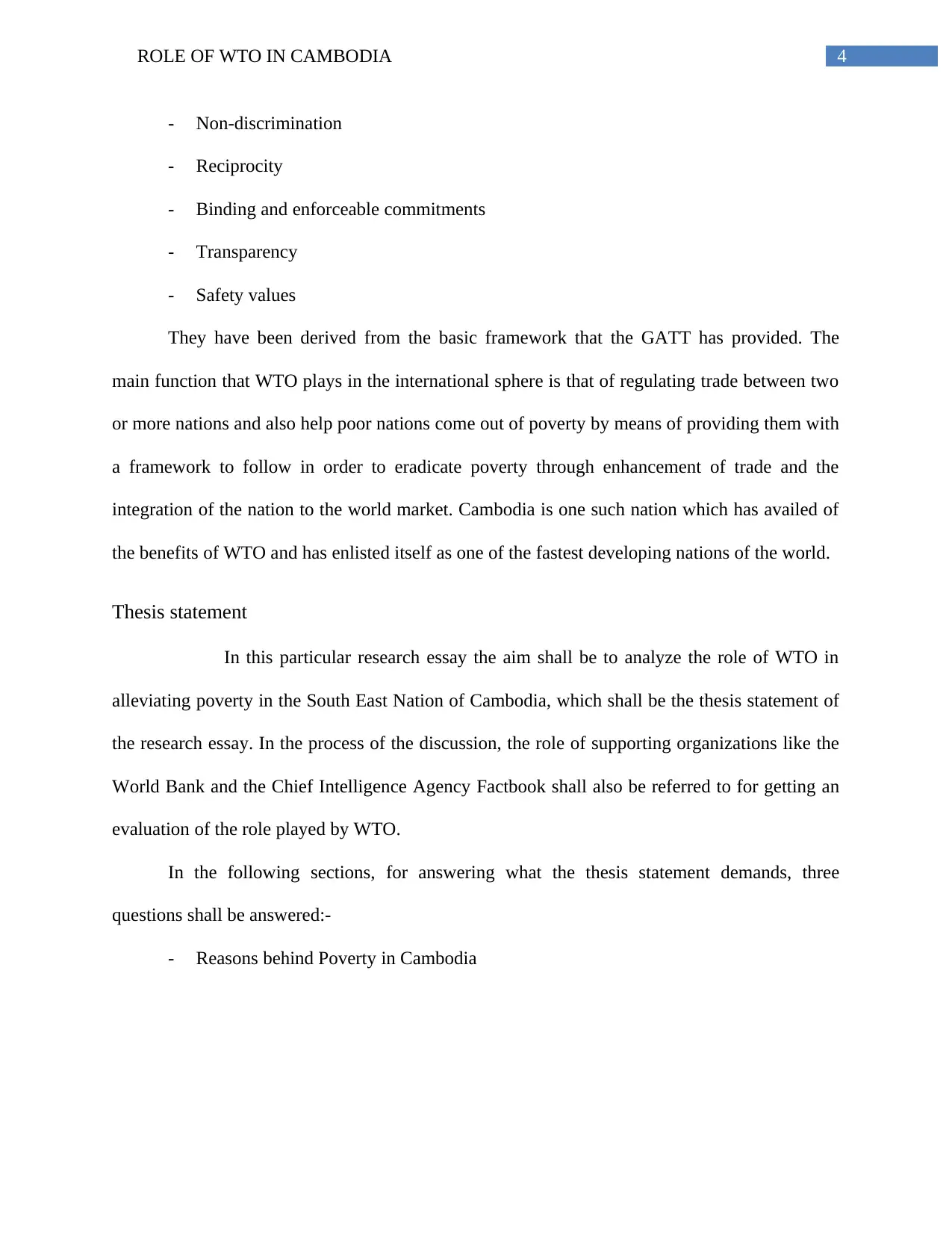
4ROLE OF WTO IN CAMBODIA
- Non-discrimination
- Reciprocity
- Binding and enforceable commitments
- Transparency
- Safety values
They have been derived from the basic framework that the GATT has provided. The
main function that WTO plays in the international sphere is that of regulating trade between two
or more nations and also help poor nations come out of poverty by means of providing them with
a framework to follow in order to eradicate poverty through enhancement of trade and the
integration of the nation to the world market. Cambodia is one such nation which has availed of
the benefits of WTO and has enlisted itself as one of the fastest developing nations of the world.
Thesis statement
In this particular research essay the aim shall be to analyze the role of WTO in
alleviating poverty in the South East Nation of Cambodia, which shall be the thesis statement of
the research essay. In the process of the discussion, the role of supporting organizations like the
World Bank and the Chief Intelligence Agency Factbook shall also be referred to for getting an
evaluation of the role played by WTO.
In the following sections, for answering what the thesis statement demands, three
questions shall be answered:-
- Reasons behind Poverty in Cambodia
- Non-discrimination
- Reciprocity
- Binding and enforceable commitments
- Transparency
- Safety values
They have been derived from the basic framework that the GATT has provided. The
main function that WTO plays in the international sphere is that of regulating trade between two
or more nations and also help poor nations come out of poverty by means of providing them with
a framework to follow in order to eradicate poverty through enhancement of trade and the
integration of the nation to the world market. Cambodia is one such nation which has availed of
the benefits of WTO and has enlisted itself as one of the fastest developing nations of the world.
Thesis statement
In this particular research essay the aim shall be to analyze the role of WTO in
alleviating poverty in the South East Nation of Cambodia, which shall be the thesis statement of
the research essay. In the process of the discussion, the role of supporting organizations like the
World Bank and the Chief Intelligence Agency Factbook shall also be referred to for getting an
evaluation of the role played by WTO.
In the following sections, for answering what the thesis statement demands, three
questions shall be answered:-
- Reasons behind Poverty in Cambodia
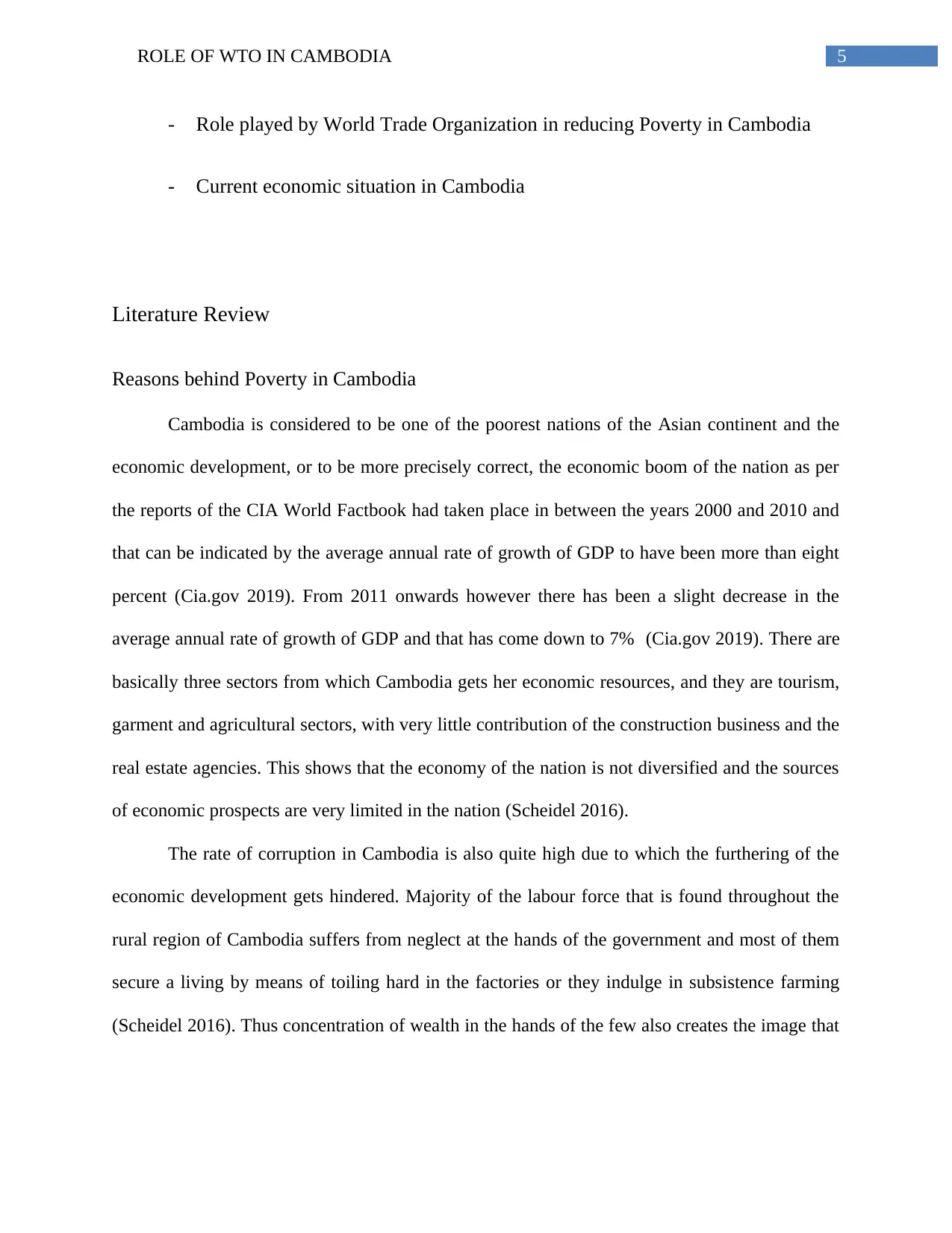
5ROLE OF WTO IN CAMBODIA
- Role played by World Trade Organization in reducing Poverty in Cambodia
- Current economic situation in Cambodia
Literature Review
Reasons behind Poverty in Cambodia
Cambodia is considered to be one of the poorest nations of the Asian continent and the
economic development, or to be more precisely correct, the economic boom of the nation as per
the reports of the CIA World Factbook had taken place in between the years 2000 and 2010 and
that can be indicated by the average annual rate of growth of GDP to have been more than eight
percent (Cia.gov 2019). From 2011 onwards however there has been a slight decrease in the
average annual rate of growth of GDP and that has come down to 7% (Cia.gov 2019). There are
basically three sectors from which Cambodia gets her economic resources, and they are tourism,
garment and agricultural sectors, with very little contribution of the construction business and the
real estate agencies. This shows that the economy of the nation is not diversified and the sources
of economic prospects are very limited in the nation (Scheidel 2016).
The rate of corruption in Cambodia is also quite high due to which the furthering of the
economic development gets hindered. Majority of the labour force that is found throughout the
rural region of Cambodia suffers from neglect at the hands of the government and most of them
secure a living by means of toiling hard in the factories or they indulge in subsistence farming
(Scheidel 2016). Thus concentration of wealth in the hands of the few also creates the image that
- Role played by World Trade Organization in reducing Poverty in Cambodia
- Current economic situation in Cambodia
Literature Review
Reasons behind Poverty in Cambodia
Cambodia is considered to be one of the poorest nations of the Asian continent and the
economic development, or to be more precisely correct, the economic boom of the nation as per
the reports of the CIA World Factbook had taken place in between the years 2000 and 2010 and
that can be indicated by the average annual rate of growth of GDP to have been more than eight
percent (Cia.gov 2019). From 2011 onwards however there has been a slight decrease in the
average annual rate of growth of GDP and that has come down to 7% (Cia.gov 2019). There are
basically three sectors from which Cambodia gets her economic resources, and they are tourism,
garment and agricultural sectors, with very little contribution of the construction business and the
real estate agencies. This shows that the economy of the nation is not diversified and the sources
of economic prospects are very limited in the nation (Scheidel 2016).
The rate of corruption in Cambodia is also quite high due to which the furthering of the
economic development gets hindered. Majority of the labour force that is found throughout the
rural region of Cambodia suffers from neglect at the hands of the government and most of them
secure a living by means of toiling hard in the factories or they indulge in subsistence farming
(Scheidel 2016). Thus concentration of wealth in the hands of the few also creates the image that
⊘ This is a preview!⊘
Do you want full access?
Subscribe today to unlock all pages.

Trusted by 1+ million students worldwide
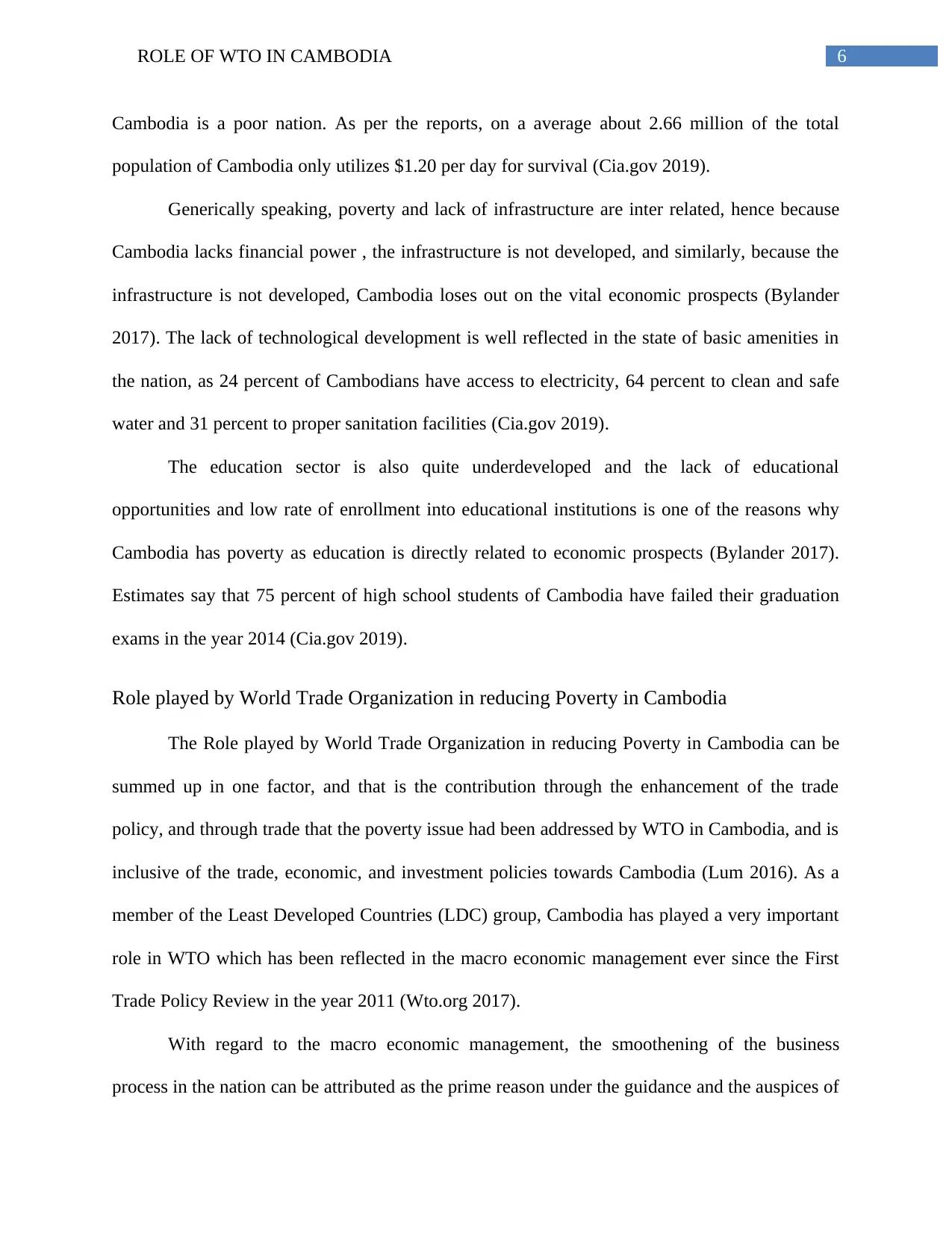
6ROLE OF WTO IN CAMBODIA
Cambodia is a poor nation. As per the reports, on a average about 2.66 million of the total
population of Cambodia only utilizes $1.20 per day for survival (Cia.gov 2019).
Generically speaking, poverty and lack of infrastructure are inter related, hence because
Cambodia lacks financial power , the infrastructure is not developed, and similarly, because the
infrastructure is not developed, Cambodia loses out on the vital economic prospects (Bylander
2017). The lack of technological development is well reflected in the state of basic amenities in
the nation, as 24 percent of Cambodians have access to electricity, 64 percent to clean and safe
water and 31 percent to proper sanitation facilities (Cia.gov 2019).
The education sector is also quite underdeveloped and the lack of educational
opportunities and low rate of enrollment into educational institutions is one of the reasons why
Cambodia has poverty as education is directly related to economic prospects (Bylander 2017).
Estimates say that 75 percent of high school students of Cambodia have failed their graduation
exams in the year 2014 (Cia.gov 2019).
Role played by World Trade Organization in reducing Poverty in Cambodia
The Role played by World Trade Organization in reducing Poverty in Cambodia can be
summed up in one factor, and that is the contribution through the enhancement of the trade
policy, and through trade that the poverty issue had been addressed by WTO in Cambodia, and is
inclusive of the trade, economic, and investment policies towards Cambodia (Lum 2016). As a
member of the Least Developed Countries (LDC) group, Cambodia has played a very important
role in WTO which has been reflected in the macro economic management ever since the First
Trade Policy Review in the year 2011 (Wto.org 2017).
With regard to the macro economic management, the smoothening of the business
process in the nation can be attributed as the prime reason under the guidance and the auspices of
Cambodia is a poor nation. As per the reports, on a average about 2.66 million of the total
population of Cambodia only utilizes $1.20 per day for survival (Cia.gov 2019).
Generically speaking, poverty and lack of infrastructure are inter related, hence because
Cambodia lacks financial power , the infrastructure is not developed, and similarly, because the
infrastructure is not developed, Cambodia loses out on the vital economic prospects (Bylander
2017). The lack of technological development is well reflected in the state of basic amenities in
the nation, as 24 percent of Cambodians have access to electricity, 64 percent to clean and safe
water and 31 percent to proper sanitation facilities (Cia.gov 2019).
The education sector is also quite underdeveloped and the lack of educational
opportunities and low rate of enrollment into educational institutions is one of the reasons why
Cambodia has poverty as education is directly related to economic prospects (Bylander 2017).
Estimates say that 75 percent of high school students of Cambodia have failed their graduation
exams in the year 2014 (Cia.gov 2019).
Role played by World Trade Organization in reducing Poverty in Cambodia
The Role played by World Trade Organization in reducing Poverty in Cambodia can be
summed up in one factor, and that is the contribution through the enhancement of the trade
policy, and through trade that the poverty issue had been addressed by WTO in Cambodia, and is
inclusive of the trade, economic, and investment policies towards Cambodia (Lum 2016). As a
member of the Least Developed Countries (LDC) group, Cambodia has played a very important
role in WTO which has been reflected in the macro economic management ever since the First
Trade Policy Review in the year 2011 (Wto.org 2017).
With regard to the macro economic management, the smoothening of the business
process in the nation can be attributed as the prime reason under the guidance and the auspices of
Paraphrase This Document
Need a fresh take? Get an instant paraphrase of this document with our AI Paraphraser
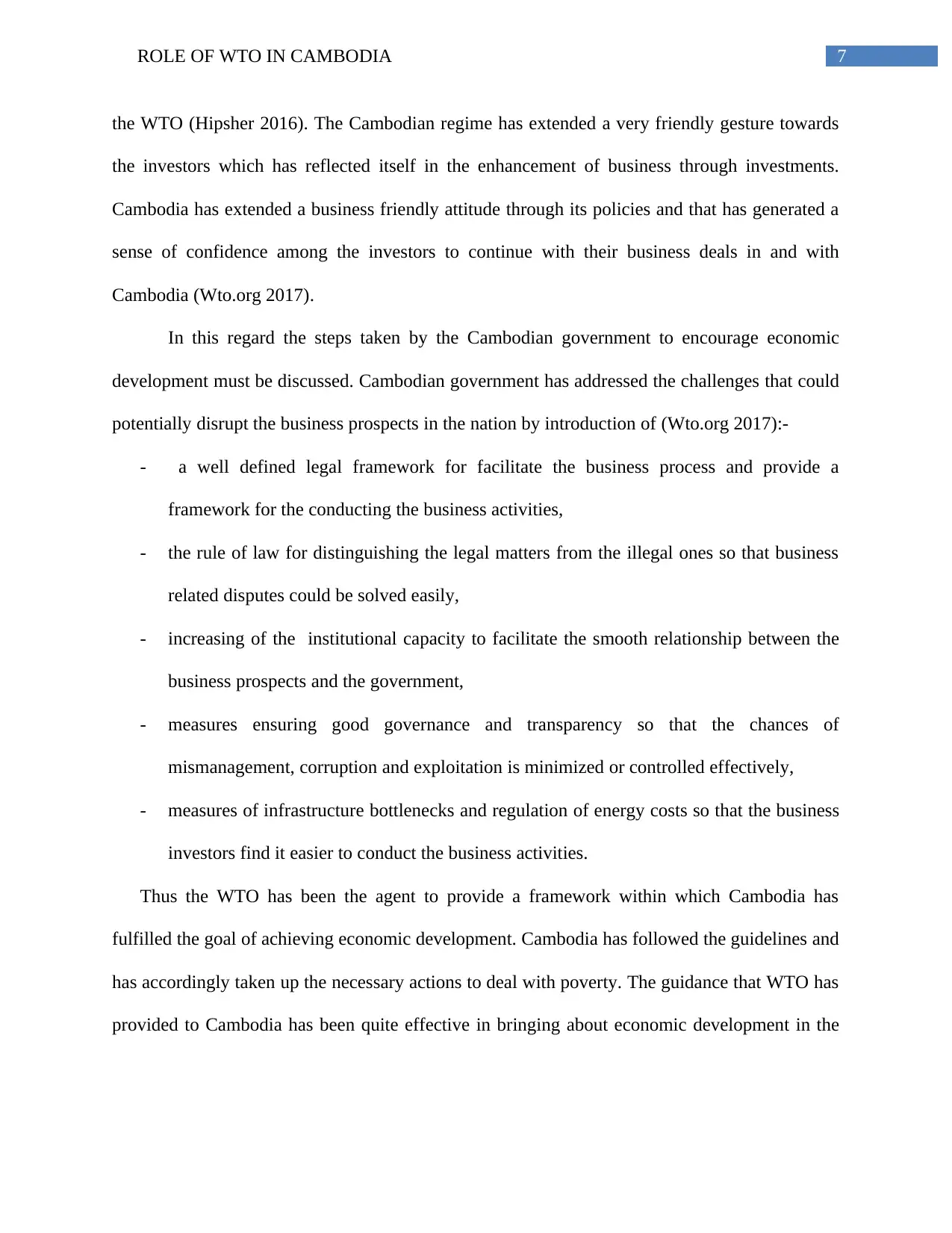
7ROLE OF WTO IN CAMBODIA
the WTO (Hipsher 2016). The Cambodian regime has extended a very friendly gesture towards
the investors which has reflected itself in the enhancement of business through investments.
Cambodia has extended a business friendly attitude through its policies and that has generated a
sense of confidence among the investors to continue with their business deals in and with
Cambodia (Wto.org 2017).
In this regard the steps taken by the Cambodian government to encourage economic
development must be discussed. Cambodian government has addressed the challenges that could
potentially disrupt the business prospects in the nation by introduction of (Wto.org 2017):-
- a well defined legal framework for facilitate the business process and provide a
framework for the conducting the business activities,
- the rule of law for distinguishing the legal matters from the illegal ones so that business
related disputes could be solved easily,
- increasing of the institutional capacity to facilitate the smooth relationship between the
business prospects and the government,
- measures ensuring good governance and transparency so that the chances of
mismanagement, corruption and exploitation is minimized or controlled effectively,
- measures of infrastructure bottlenecks and regulation of energy costs so that the business
investors find it easier to conduct the business activities.
Thus the WTO has been the agent to provide a framework within which Cambodia has
fulfilled the goal of achieving economic development. Cambodia has followed the guidelines and
has accordingly taken up the necessary actions to deal with poverty. The guidance that WTO has
provided to Cambodia has been quite effective in bringing about economic development in the
the WTO (Hipsher 2016). The Cambodian regime has extended a very friendly gesture towards
the investors which has reflected itself in the enhancement of business through investments.
Cambodia has extended a business friendly attitude through its policies and that has generated a
sense of confidence among the investors to continue with their business deals in and with
Cambodia (Wto.org 2017).
In this regard the steps taken by the Cambodian government to encourage economic
development must be discussed. Cambodian government has addressed the challenges that could
potentially disrupt the business prospects in the nation by introduction of (Wto.org 2017):-
- a well defined legal framework for facilitate the business process and provide a
framework for the conducting the business activities,
- the rule of law for distinguishing the legal matters from the illegal ones so that business
related disputes could be solved easily,
- increasing of the institutional capacity to facilitate the smooth relationship between the
business prospects and the government,
- measures ensuring good governance and transparency so that the chances of
mismanagement, corruption and exploitation is minimized or controlled effectively,
- measures of infrastructure bottlenecks and regulation of energy costs so that the business
investors find it easier to conduct the business activities.
Thus the WTO has been the agent to provide a framework within which Cambodia has
fulfilled the goal of achieving economic development. Cambodia has followed the guidelines and
has accordingly taken up the necessary actions to deal with poverty. The guidance that WTO has
provided to Cambodia has been quite effective in bringing about economic development in the
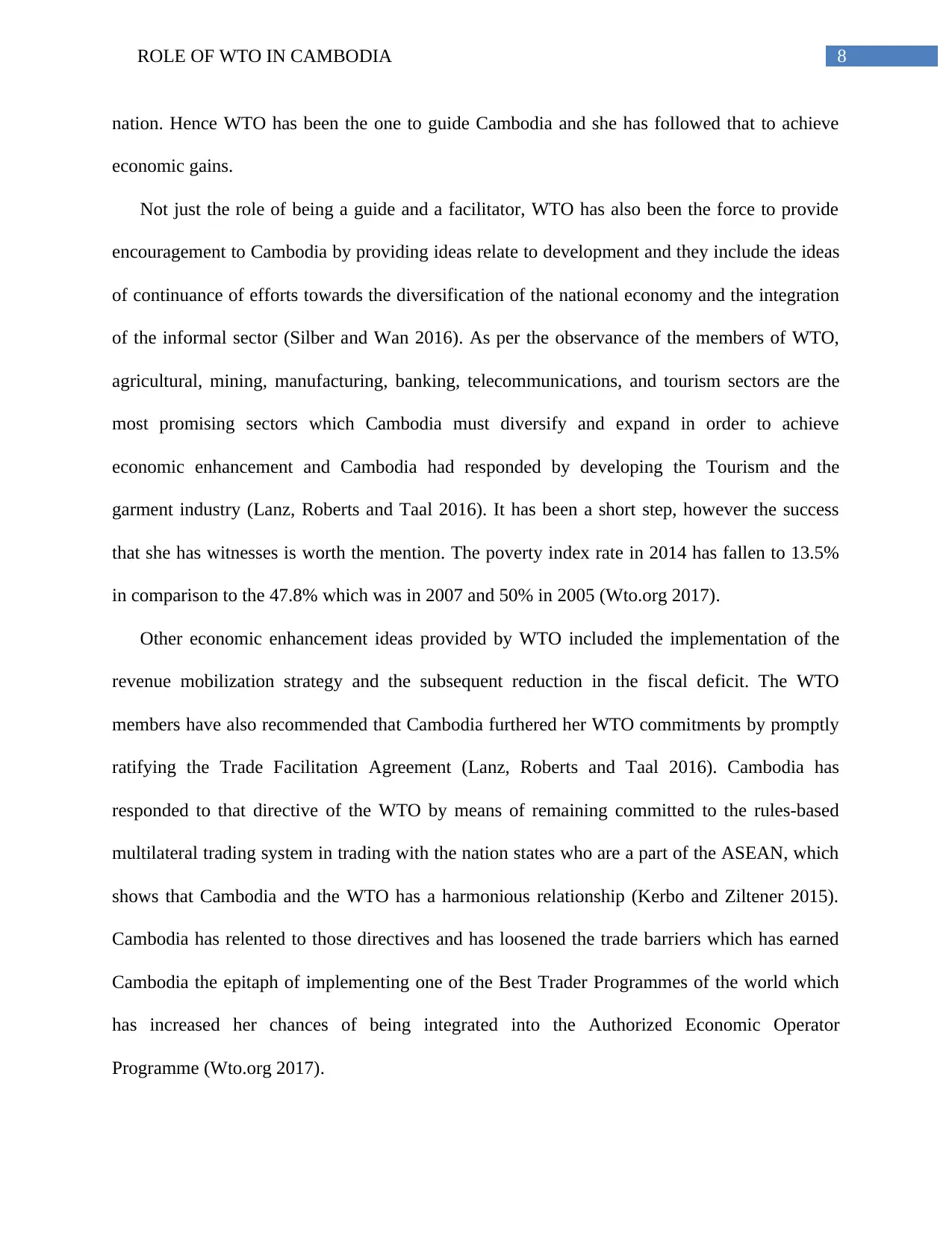
8ROLE OF WTO IN CAMBODIA
nation. Hence WTO has been the one to guide Cambodia and she has followed that to achieve
economic gains.
Not just the role of being a guide and a facilitator, WTO has also been the force to provide
encouragement to Cambodia by providing ideas relate to development and they include the ideas
of continuance of efforts towards the diversification of the national economy and the integration
of the informal sector (Silber and Wan 2016). As per the observance of the members of WTO,
agricultural, mining, manufacturing, banking, telecommunications, and tourism sectors are the
most promising sectors which Cambodia must diversify and expand in order to achieve
economic enhancement and Cambodia had responded by developing the Tourism and the
garment industry (Lanz, Roberts and Taal 2016). It has been a short step, however the success
that she has witnesses is worth the mention. The poverty index rate in 2014 has fallen to 13.5%
in comparison to the 47.8% which was in 2007 and 50% in 2005 (Wto.org 2017).
Other economic enhancement ideas provided by WTO included the implementation of the
revenue mobilization strategy and the subsequent reduction in the fiscal deficit. The WTO
members have also recommended that Cambodia furthered her WTO commitments by promptly
ratifying the Trade Facilitation Agreement (Lanz, Roberts and Taal 2016). Cambodia has
responded to that directive of the WTO by means of remaining committed to the rules-based
multilateral trading system in trading with the nation states who are a part of the ASEAN, which
shows that Cambodia and the WTO has a harmonious relationship (Kerbo and Ziltener 2015).
Cambodia has relented to those directives and has loosened the trade barriers which has earned
Cambodia the epitaph of implementing one of the Best Trader Programmes of the world which
has increased her chances of being integrated into the Authorized Economic Operator
Programme (Wto.org 2017).
nation. Hence WTO has been the one to guide Cambodia and she has followed that to achieve
economic gains.
Not just the role of being a guide and a facilitator, WTO has also been the force to provide
encouragement to Cambodia by providing ideas relate to development and they include the ideas
of continuance of efforts towards the diversification of the national economy and the integration
of the informal sector (Silber and Wan 2016). As per the observance of the members of WTO,
agricultural, mining, manufacturing, banking, telecommunications, and tourism sectors are the
most promising sectors which Cambodia must diversify and expand in order to achieve
economic enhancement and Cambodia had responded by developing the Tourism and the
garment industry (Lanz, Roberts and Taal 2016). It has been a short step, however the success
that she has witnesses is worth the mention. The poverty index rate in 2014 has fallen to 13.5%
in comparison to the 47.8% which was in 2007 and 50% in 2005 (Wto.org 2017).
Other economic enhancement ideas provided by WTO included the implementation of the
revenue mobilization strategy and the subsequent reduction in the fiscal deficit. The WTO
members have also recommended that Cambodia furthered her WTO commitments by promptly
ratifying the Trade Facilitation Agreement (Lanz, Roberts and Taal 2016). Cambodia has
responded to that directive of the WTO by means of remaining committed to the rules-based
multilateral trading system in trading with the nation states who are a part of the ASEAN, which
shows that Cambodia and the WTO has a harmonious relationship (Kerbo and Ziltener 2015).
Cambodia has relented to those directives and has loosened the trade barriers which has earned
Cambodia the epitaph of implementing one of the Best Trader Programmes of the world which
has increased her chances of being integrated into the Authorized Economic Operator
Programme (Wto.org 2017).
⊘ This is a preview!⊘
Do you want full access?
Subscribe today to unlock all pages.

Trusted by 1+ million students worldwide
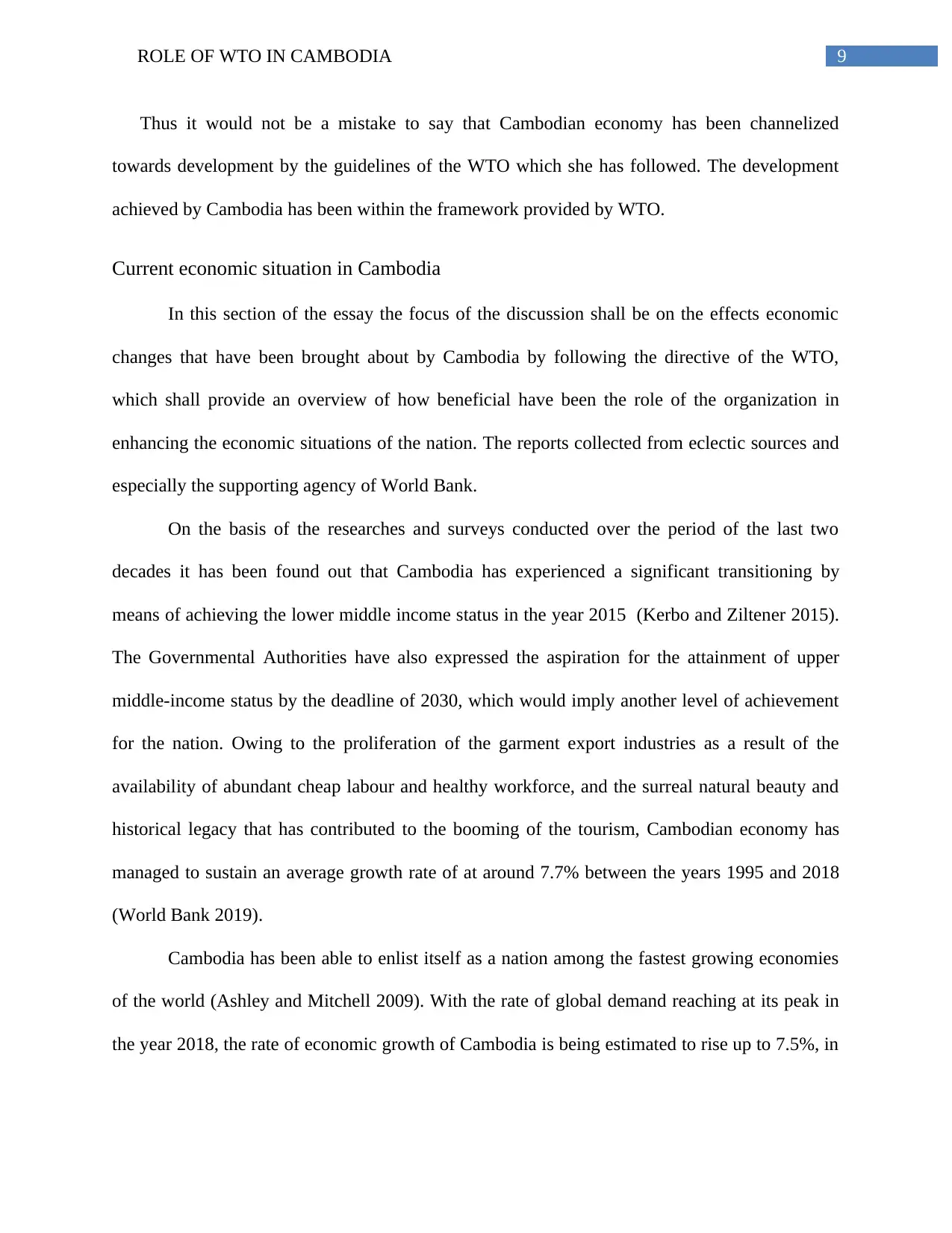
9ROLE OF WTO IN CAMBODIA
Thus it would not be a mistake to say that Cambodian economy has been channelized
towards development by the guidelines of the WTO which she has followed. The development
achieved by Cambodia has been within the framework provided by WTO.
Current economic situation in Cambodia
In this section of the essay the focus of the discussion shall be on the effects economic
changes that have been brought about by Cambodia by following the directive of the WTO,
which shall provide an overview of how beneficial have been the role of the organization in
enhancing the economic situations of the nation. The reports collected from eclectic sources and
especially the supporting agency of World Bank.
On the basis of the researches and surveys conducted over the period of the last two
decades it has been found out that Cambodia has experienced a significant transitioning by
means of achieving the lower middle income status in the year 2015 (Kerbo and Ziltener 2015).
The Governmental Authorities have also expressed the aspiration for the attainment of upper
middle-income status by the deadline of 2030, which would imply another level of achievement
for the nation. Owing to the proliferation of the garment export industries as a result of the
availability of abundant cheap labour and healthy workforce, and the surreal natural beauty and
historical legacy that has contributed to the booming of the tourism, Cambodian economy has
managed to sustain an average growth rate of at around 7.7% between the years 1995 and 2018
(World Bank 2019).
Cambodia has been able to enlist itself as a nation among the fastest growing economies
of the world (Ashley and Mitchell 2009). With the rate of global demand reaching at its peak in
the year 2018, the rate of economic growth of Cambodia is being estimated to rise up to 7.5%, in
Thus it would not be a mistake to say that Cambodian economy has been channelized
towards development by the guidelines of the WTO which she has followed. The development
achieved by Cambodia has been within the framework provided by WTO.
Current economic situation in Cambodia
In this section of the essay the focus of the discussion shall be on the effects economic
changes that have been brought about by Cambodia by following the directive of the WTO,
which shall provide an overview of how beneficial have been the role of the organization in
enhancing the economic situations of the nation. The reports collected from eclectic sources and
especially the supporting agency of World Bank.
On the basis of the researches and surveys conducted over the period of the last two
decades it has been found out that Cambodia has experienced a significant transitioning by
means of achieving the lower middle income status in the year 2015 (Kerbo and Ziltener 2015).
The Governmental Authorities have also expressed the aspiration for the attainment of upper
middle-income status by the deadline of 2030, which would imply another level of achievement
for the nation. Owing to the proliferation of the garment export industries as a result of the
availability of abundant cheap labour and healthy workforce, and the surreal natural beauty and
historical legacy that has contributed to the booming of the tourism, Cambodian economy has
managed to sustain an average growth rate of at around 7.7% between the years 1995 and 2018
(World Bank 2019).
Cambodia has been able to enlist itself as a nation among the fastest growing economies
of the world (Ashley and Mitchell 2009). With the rate of global demand reaching at its peak in
the year 2018, the rate of economic growth of Cambodia is being estimated to rise up to 7.5%, in
Paraphrase This Document
Need a fresh take? Get an instant paraphrase of this document with our AI Paraphraser
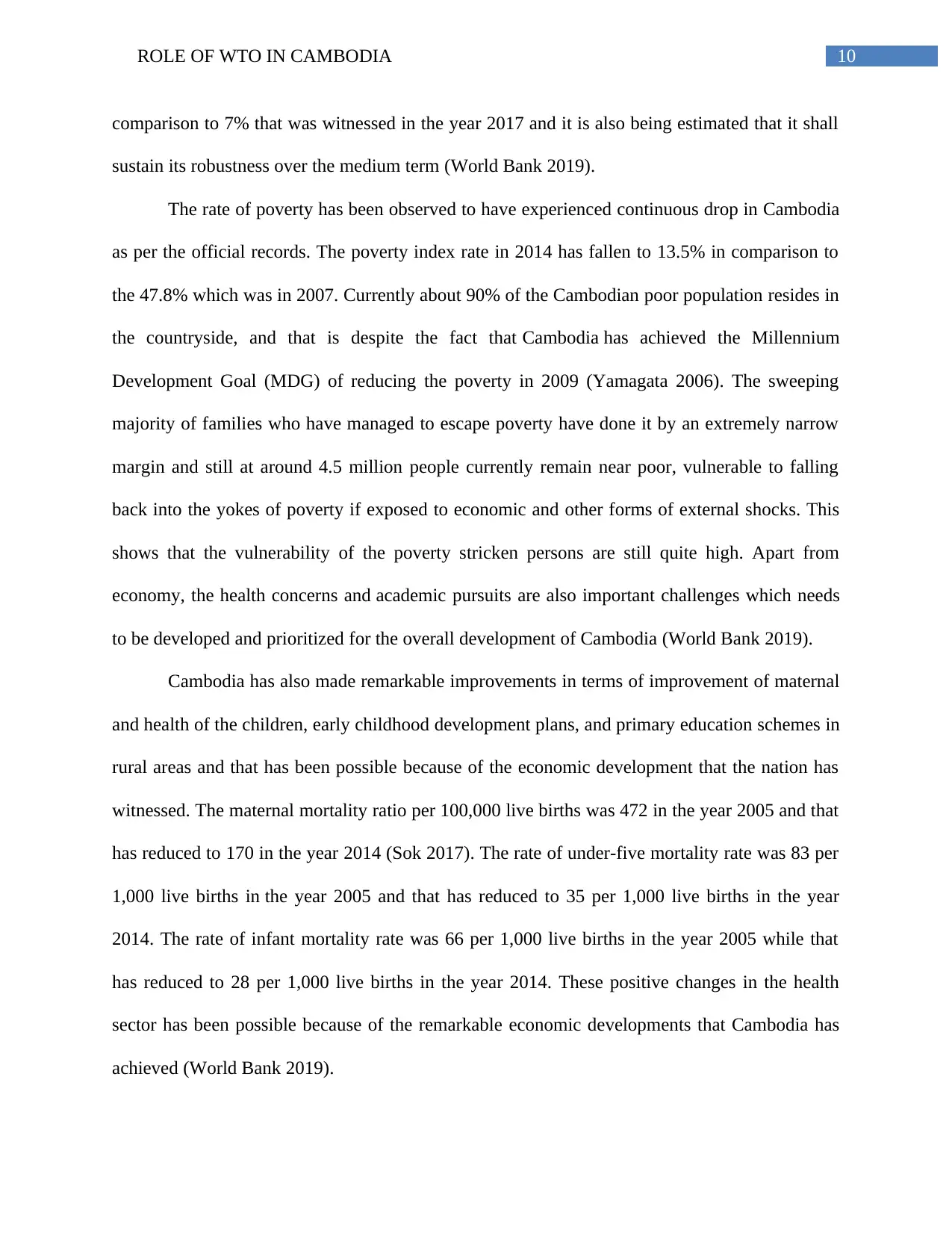
10ROLE OF WTO IN CAMBODIA
comparison to 7% that was witnessed in the year 2017 and it is also being estimated that it shall
sustain its robustness over the medium term (World Bank 2019).
The rate of poverty has been observed to have experienced continuous drop in Cambodia
as per the official records. The poverty index rate in 2014 has fallen to 13.5% in comparison to
the 47.8% which was in 2007. Currently about 90% of the Cambodian poor population resides in
the countryside, and that is despite the fact that Cambodia has achieved the Millennium
Development Goal (MDG) of reducing the poverty in 2009 (Yamagata 2006). The sweeping
majority of families who have managed to escape poverty have done it by an extremely narrow
margin and still at around 4.5 million people currently remain near poor, vulnerable to falling
back into the yokes of poverty if exposed to economic and other forms of external shocks. This
shows that the vulnerability of the poverty stricken persons are still quite high. Apart from
economy, the health concerns and academic pursuits are also important challenges which needs
to be developed and prioritized for the overall development of Cambodia (World Bank 2019).
Cambodia has also made remarkable improvements in terms of improvement of maternal
and health of the children, early childhood development plans, and primary education schemes in
rural areas and that has been possible because of the economic development that the nation has
witnessed. The maternal mortality ratio per 100,000 live births was 472 in the year 2005 and that
has reduced to 170 in the year 2014 (Sok 2017). The rate of under-five mortality rate was 83 per
1,000 live births in the year 2005 and that has reduced to 35 per 1,000 live births in the year
2014. The rate of infant mortality rate was 66 per 1,000 live births in the year 2005 while that
has reduced to 28 per 1,000 live births in the year 2014. These positive changes in the health
sector has been possible because of the remarkable economic developments that Cambodia has
achieved (World Bank 2019).
comparison to 7% that was witnessed in the year 2017 and it is also being estimated that it shall
sustain its robustness over the medium term (World Bank 2019).
The rate of poverty has been observed to have experienced continuous drop in Cambodia
as per the official records. The poverty index rate in 2014 has fallen to 13.5% in comparison to
the 47.8% which was in 2007. Currently about 90% of the Cambodian poor population resides in
the countryside, and that is despite the fact that Cambodia has achieved the Millennium
Development Goal (MDG) of reducing the poverty in 2009 (Yamagata 2006). The sweeping
majority of families who have managed to escape poverty have done it by an extremely narrow
margin and still at around 4.5 million people currently remain near poor, vulnerable to falling
back into the yokes of poverty if exposed to economic and other forms of external shocks. This
shows that the vulnerability of the poverty stricken persons are still quite high. Apart from
economy, the health concerns and academic pursuits are also important challenges which needs
to be developed and prioritized for the overall development of Cambodia (World Bank 2019).
Cambodia has also made remarkable improvements in terms of improvement of maternal
and health of the children, early childhood development plans, and primary education schemes in
rural areas and that has been possible because of the economic development that the nation has
witnessed. The maternal mortality ratio per 100,000 live births was 472 in the year 2005 and that
has reduced to 170 in the year 2014 (Sok 2017). The rate of under-five mortality rate was 83 per
1,000 live births in the year 2005 and that has reduced to 35 per 1,000 live births in the year
2014. The rate of infant mortality rate was 66 per 1,000 live births in the year 2005 while that
has reduced to 28 per 1,000 live births in the year 2014. These positive changes in the health
sector has been possible because of the remarkable economic developments that Cambodia has
achieved (World Bank 2019).
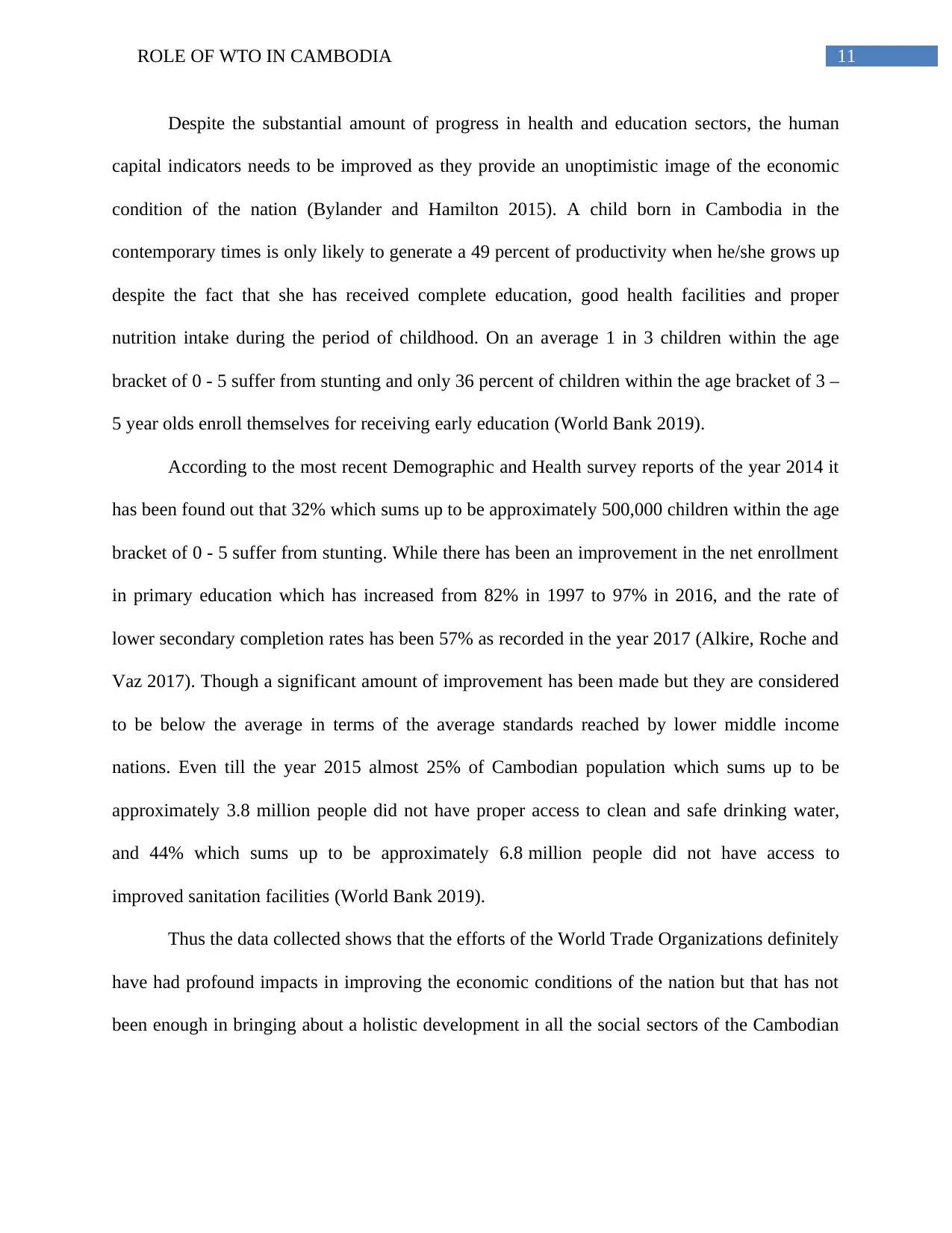
11ROLE OF WTO IN CAMBODIA
Despite the substantial amount of progress in health and education sectors, the human
capital indicators needs to be improved as they provide an unoptimistic image of the economic
condition of the nation (Bylander and Hamilton 2015). A child born in Cambodia in the
contemporary times is only likely to generate a 49 percent of productivity when he/she grows up
despite the fact that she has received complete education, good health facilities and proper
nutrition intake during the period of childhood. On an average 1 in 3 children within the age
bracket of 0 - 5 suffer from stunting and only 36 percent of children within the age bracket of 3 –
5 year olds enroll themselves for receiving early education (World Bank 2019).
According to the most recent Demographic and Health survey reports of the year 2014 it
has been found out that 32% which sums up to be approximately 500,000 children within the age
bracket of 0 - 5 suffer from stunting. While there has been an improvement in the net enrollment
in primary education which has increased from 82% in 1997 to 97% in 2016, and the rate of
lower secondary completion rates has been 57% as recorded in the year 2017 (Alkire, Roche and
Vaz 2017). Though a significant amount of improvement has been made but they are considered
to be below the average in terms of the average standards reached by lower middle income
nations. Even till the year 2015 almost 25% of Cambodian population which sums up to be
approximately 3.8 million people did not have proper access to clean and safe drinking water,
and 44% which sums up to be approximately 6.8 million people did not have access to
improved sanitation facilities (World Bank 2019).
Thus the data collected shows that the efforts of the World Trade Organizations definitely
have had profound impacts in improving the economic conditions of the nation but that has not
been enough in bringing about a holistic development in all the social sectors of the Cambodian
Despite the substantial amount of progress in health and education sectors, the human
capital indicators needs to be improved as they provide an unoptimistic image of the economic
condition of the nation (Bylander and Hamilton 2015). A child born in Cambodia in the
contemporary times is only likely to generate a 49 percent of productivity when he/she grows up
despite the fact that she has received complete education, good health facilities and proper
nutrition intake during the period of childhood. On an average 1 in 3 children within the age
bracket of 0 - 5 suffer from stunting and only 36 percent of children within the age bracket of 3 –
5 year olds enroll themselves for receiving early education (World Bank 2019).
According to the most recent Demographic and Health survey reports of the year 2014 it
has been found out that 32% which sums up to be approximately 500,000 children within the age
bracket of 0 - 5 suffer from stunting. While there has been an improvement in the net enrollment
in primary education which has increased from 82% in 1997 to 97% in 2016, and the rate of
lower secondary completion rates has been 57% as recorded in the year 2017 (Alkire, Roche and
Vaz 2017). Though a significant amount of improvement has been made but they are considered
to be below the average in terms of the average standards reached by lower middle income
nations. Even till the year 2015 almost 25% of Cambodian population which sums up to be
approximately 3.8 million people did not have proper access to clean and safe drinking water,
and 44% which sums up to be approximately 6.8 million people did not have access to
improved sanitation facilities (World Bank 2019).
Thus the data collected shows that the efforts of the World Trade Organizations definitely
have had profound impacts in improving the economic conditions of the nation but that has not
been enough in bringing about a holistic development in all the social sectors of the Cambodian
⊘ This is a preview!⊘
Do you want full access?
Subscribe today to unlock all pages.

Trusted by 1+ million students worldwide
1 out of 20
Related Documents
Your All-in-One AI-Powered Toolkit for Academic Success.
+13062052269
info@desklib.com
Available 24*7 on WhatsApp / Email
![[object Object]](/_next/static/media/star-bottom.7253800d.svg)
Unlock your academic potential
Copyright © 2020–2025 A2Z Services. All Rights Reserved. Developed and managed by ZUCOL.




